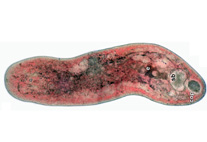Abstract
An integrative taxonomy approach is used to characterise the diversity of gorgoderid trematodes that parasitize freshwater fishes of the subfamily Goodeinae in central Mexico. Records of Phyllodistomum sp. and Dendrorchis sp. from the urinary bladder of goodeines have been previously published, although the identification at species level was not achieved. A few specimens were collected and fixed to conduct a scanning electron microscopy study, and to obtain sequences of a mitochondrial (COI) and nuclear (28S rRNA) gene, to be analysed in the context of the molecular phylogeny of gorgoderid trematodes. Based on the new findings, two new species of Phyllodistomum Braun, 1899 are described. Phyllodistomum cribbi n. sp. was found in Zoogoneticus quitzeoensis (Bean), Allotoca zacapuensis Meyer, Radda & Domínguez-Domínguez, Hubbsina turneri de Buen and Z. purhepechus Domínguez-Domínguez, Pérez-Rodríguez & Doadrio from Zacapu Lake, and La Luz Spring, in Michoacan, central Mexico. Phyllodistomum wallacei n. sp. parasitized Xenotaenia resolanae Turner, Ilyodon furcidens (Jordan & Gilbert), and Allodontichthys tamazulae Turner from the Cuzalapa, Ayuquila and Tamazula Rivers in Jalisco, western Mexico. These species are compared with several freshwater Phyllodistomum species from different areas of the world, especially a group of eight species that comprise a monophyletic clade in recent phylogenetic hypotheses of the Gorgoderidae Looss, 1899. The two new species are distinguished from other close relatives by the combination of morphological traits such as the body shape, sucker ratio, shape of the gonads, and extension of intestinal ceca. The new species are distinct in some ultrastructural characters of the body surface when compared with those species where scanning electron micrographs (SEM) and/or microphotographs are available. Data of two molecular markers (28S rRNA and COI genes) demonstrate that the two new species are distinct from each other and from those species of Phyllodistomum Braun, 1899 for which sequences are available.

